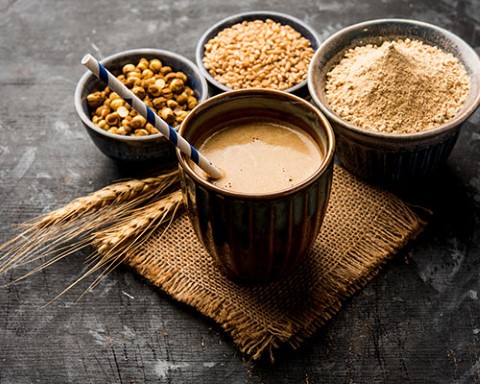Known as the “Southwest Monsoon” season, India usually receives its heaviest rainfall from June to September. The month with the warmest average temperature in India is May, while in the U.S., July is typically the hottest month.
One of the traditional ways that many Indians try to beat the heat is through consuming “cooling” foods, like kanji (or “congee”) rice. Note that “kanji” can refer to fermented rice water or fermented spiced drinks. This specific dish is also known as “panta bhat” (in Bengali or Assam) and “neeragaram” (in Tamil). Another example is a sweet or salty beverage made with roasted black chickpea flour and other ingredients, called sattu sharbat. Kanji rice is essentially a fermented rice dish for any daily meal but is often consumed as, or with, breakfast. These foods are believed to help prevent dehydration, enhance immunity and energy, aid digestion, and boost healthy skin and hair.

Pictured above, Sattu sharbat is a cooling sweet drink made in summer with roasted black chickpea flour, barley, suger, salt & water.
Referred to in Sanskrit literature as peya or peyak, kanji rice has been a part of Indian cuisine for centuries. Containing essential nutrients such as iron, vitamin B and other important minerals, kanji rice is a light dish that’s easy to digest. A staple in many Indian and Asian households, it is also commonly prepared and served for those recovering from illnesses. Allowing the rice to ferment transforms the dish into a natural probiotic, aiding nutrient absorption and overall gut health.
So, whether you want to try it as a coolant, an immunity booster or just to connect with another culture and get a taste of something the child you support is likely familiar with, we encourage you to try this simple dish, using the recipe below as a guide.




Makes approximately 3-5 servings.
The variety of recipes for this dish are practically endless, so we encourage you to substitute other vegetables, spices and herbs to suit your palette. You can garnish it with cilantro leaves and add a dollop of plain yogurt, for example. Or try mixing in cashews for extra protein and crunch. In addition to being served with mashed potatoes, kanji rice also pairs well with pickles or simple stir-fried vegetables.
Nutrition information
One cup of kanji rice w/ garlic cloves: 138 calories / 3.4 grams protein / 0.2 grams fat / 32 grams carbohydrates
Two small potatoes: 217 calories / 5.6 grams protein / 0.3 grams fat / 50 grams carbohydrate
Post-script: One of our U.S.-based staff members did some “in-house” testing and reports the dish was easy to make, delicious and very filling — especially with mashed potatoes on the side. She substituted chopped onion for garlic, sauteed the onion in olive oil and a touch of butter and added sauteed spinach and chopped brussels sprouts.
Comments
You must be logged in to comment. If you have an account, click here to log in.